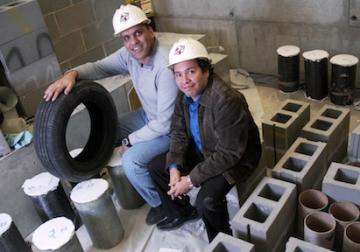Scrap tires could gain a new purpose as ingredients for construction materials, thanks to research at Missouri University of Science and Technology.
Discarded tires are a big problem. Landfills are teeming with them and they can harbor disease-carrying mosquitos and rodents. Stockpiles of old tires also burn easily — creating fires that can quickly get out of control and may burn for months or even years.
But the longevity and resilience of scrap tires also makes them ideal for other uses.
Dr. Mohamed A. El Gawady, a researcher at Missouri S&T, is currently testing new masonry blocks made with ground tires.
“Rubber has a lot of benefits in addition to its sustainability,” says El Gawady, associate professor of civil, architectural and environmental engineering. “It’s very durable and provides good insulation. Among their many potential benefits, these new blocks could cut heating bills by 50 percent.”
ElGawady has been working with Midwest Block and Brick, a Jefferson City, Mo.-based company, to create the blocks, which are made from sand and scrap tires ground to fine particles.
These rubber-added blocks, called rubberized blocks, were constructed with a variety of ratios of sand to rubber particles before coming up with the right balance.
“The rubber makes the blocks a bit weaker, so after testing various percentages, we now only replace about 20 percent of the sand with rubber, so the blocks retain their strength,” ElGawady says.
He and his students use a compression machine to test and compare the strength of prisms built with the rubberized blocks to conventional concrete masonry blocks.
Both rubberized and conventional blocks are being tested in an environmental chamber at Missouri S&T. In the chamber, the blocks undergo cycles of extreme temperatures and humidity levels, simulating different weather conditions. The rubberized blocks are also tested under cyclic compression loads simulating earthquake loads.
“Construction with these new blocks could improve a building’s resiliency during an earthquake by acting as shock absorbers,” says ElGawady.
Related Stories
Museums | Mar 11, 2024
Nebraska’s Joslyn Art Museum to reopen this summer with new Snøhetta-designed pavilion
In Omaha, Neb., the Joslyn Art Museum, which displays art from ancient times to the present, has announced it will reopen on September 10, following the completion of its new 42,000-sf Rhonda & Howard Hawks Pavilion. Designed in collaboration with Snøhetta and Alley Poyner Macchietto Architecture, the Hawks Pavilion is part of a museum overhaul that will expand the gallery space by more than 40%.
Affordable Housing | Mar 11, 2024
Los Angeles’s streamlined approval policies leading to boom in affordable housing plans
Since December 2022, Los Angeles’s planning department has received plans for more than 13,770 affordable units. The number of units put in the approval pipeline in roughly one year is just below the total number of affordable units approved in Los Angeles in 2020, 2021, and 2022 combined.
BIM and Information Technology | Mar 11, 2024
BIM at LOD400: Why Level of Development 400 matters for design and virtual construction
As construction projects grow more complex, producing a building information model at Level of Development 400 (LOD400) can accelerate schedules, increase savings, and reduce risk, writes Stephen E. Blumenbaum, PE, SE, Walter P Moore's Director of Construction Engineering.
AEC Tech | Mar 9, 2024
9 steps for implementing digital transformation in your AEC business
Regardless of a businesses size and type, digital solutions like workflow automation software, AI-based analytics, and integrations can significantly enhance efficiency, productivity, and competitiveness.
Office Buildings | Mar 8, 2024
Conference room design for the hybrid era
Sam Griesgraber, Senior Interior Designer, BWBR, shares considerations for conference room design in the era of hybrid work.
Architects | Mar 8, 2024
98 architects elevated to AIA's College of Fellows in 2024
The American Institute of Architects (AIA) is elevating 96 member-architects and 2 non-member-architects to its College of Fellows, an honor awarded to architects who have made significant contributions to the profession. The fellowship program was developed to elevate architects who have achieved a standard of excellence in the profession and made a significant contribution to architecture and society on a national level.
Sports and Recreational Facilities | Mar 7, 2024
Bjarke Ingels’ design for the Oakland A’s new Las Vegas ballpark resembles ‘a spherical armadillo’
Designed by Bjarke Ingels Group (BIG) in collaboration with HNTB, the new ballpark for the Oakland Athletics Major League Baseball team will be located on the Las Vegas Strip and offer panoramic views of the city skyline. The 33,000-capacity covered, climate-controlled stadium will sit on nine acres on Las Vegas Boulevard.
Adaptive Reuse | Mar 7, 2024
3 key considerations when converting a warehouse to a laboratory
Does your warehouse facility fit the profile for a successful laboratory conversion that can demand higher rents and lower vacancy rates? Here are three important considerations to factor before proceeding.
Shopping Centers | Mar 7, 2024
How shopping centers can foster strong community connections
In today's retail landscape, shopping centers are evolving beyond mere shopping destinations to become vibrant hubs of community life. Here are three strategies from Nadel Architecture + Planning for creating strong local connections.
Market Data | Mar 6, 2024
Nonresidential construction spending slips 0.4% in January
National nonresidential construction spending decreased 0.4% in January, according to an Associated Builders and Contractors analysis of data published today by the U.S. Census Bureau. On a seasonally adjusted annualized basis, nonresidential spending totaled $1.190 trillion.

















